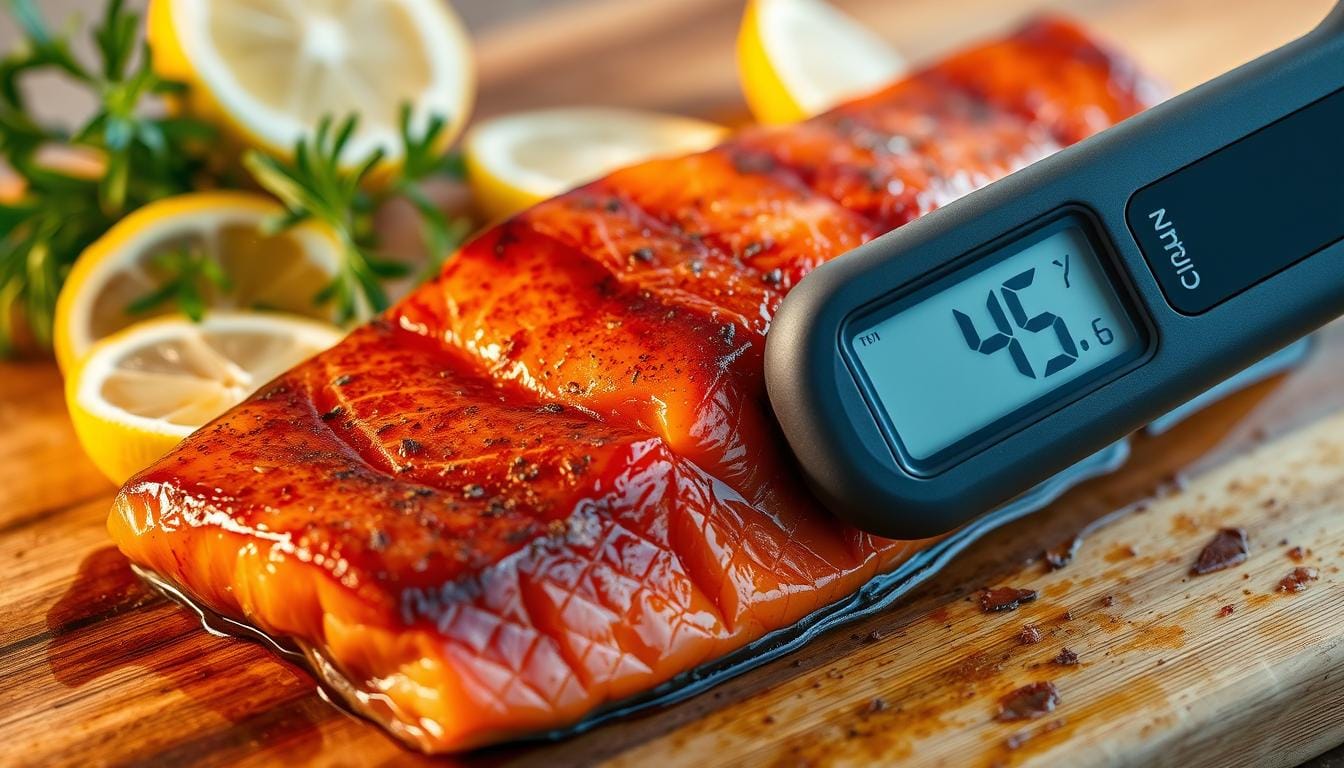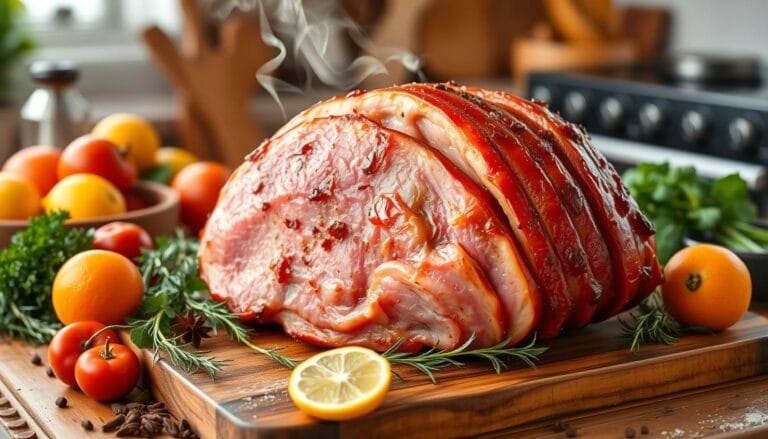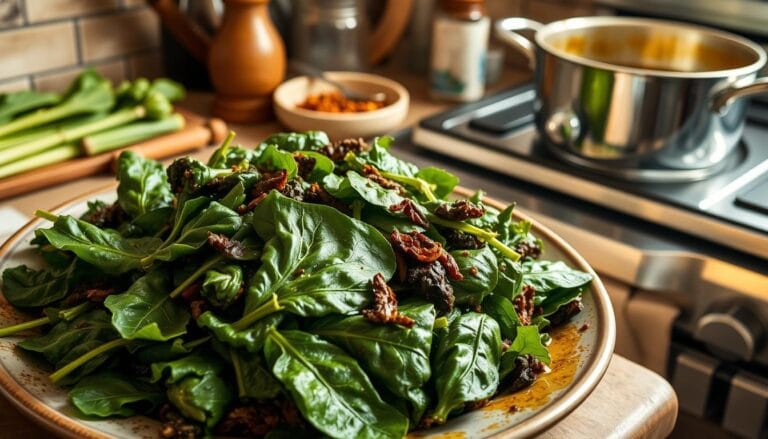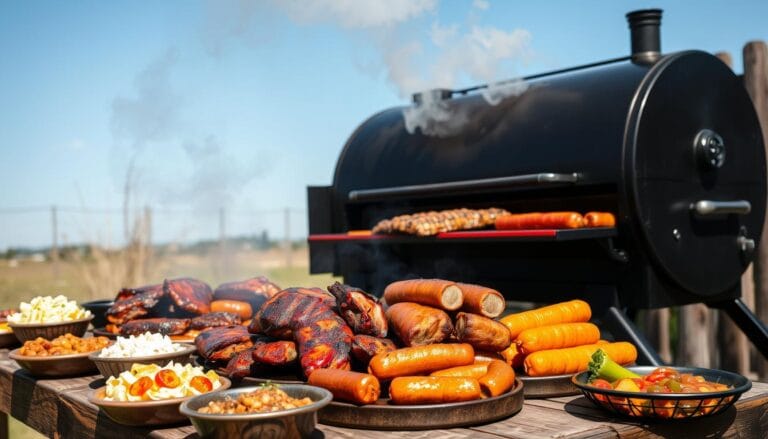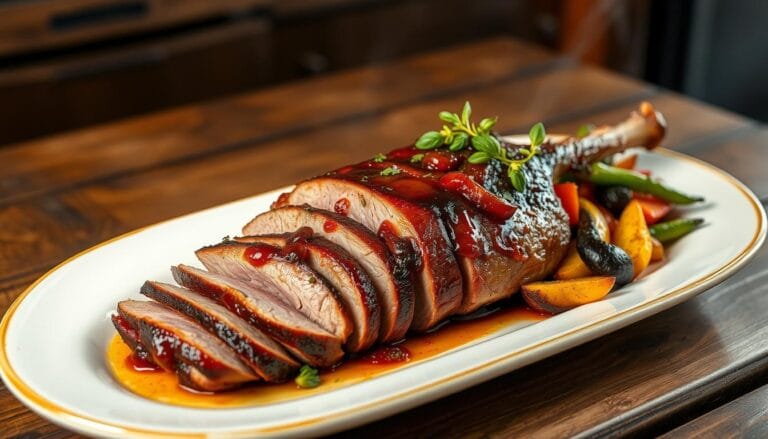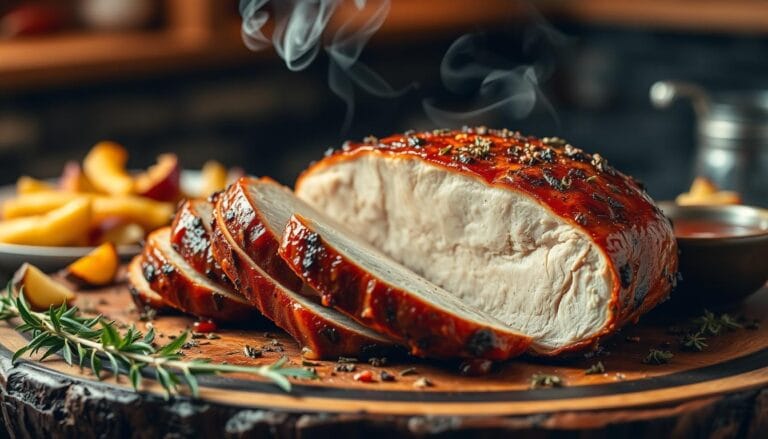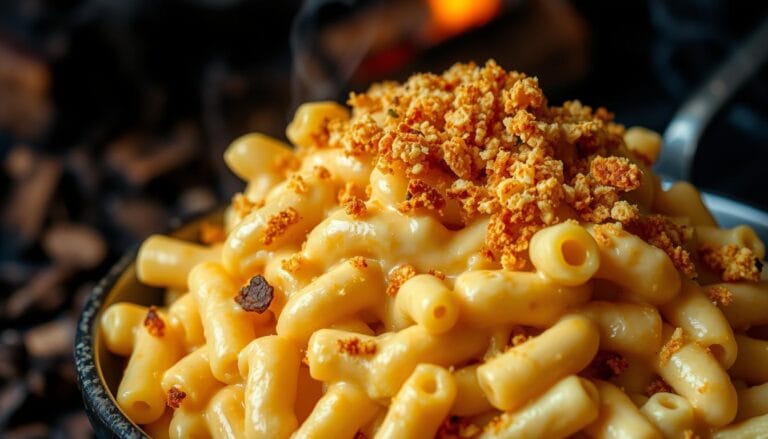Master the Art of Smoked Salmon: Achieve the Ultimate Fillet Temperature
There’s a moment of pure joy when you first taste perfectly smoked salmon. The buttery texture melts in your mouth, warming your soul. Whether it’s a weekend brunch or a casual get-together, smoked salmon is a hit with everyone.
To get this culinary delight right, knowing the right temperature is key. It’s not just cooking; it’s about getting the internal temp just right. This ensures each fillet is moist and full of flavor.
In this guide, we’ll explore the best practices for smoked salmon. From choosing the finest fish to brining and smoking, we’ll cover it all. You’ll see that making delicious, tender smoked salmon is easier than you think. Let’s start this tasty journey together and make a smoked salmon recipe that everyone will love.
Table of Contents
Understanding Smoked Salmon Temperature
Getting the temperature right when smoking salmon is key. The right temperature boosts flavor and keeps food safe. Aim for a smoker temperature of 180°F to 200°F. This ensures the salmon cooks slowly, staying moist and tender.
To check the salmon’s temperature, use a digital meat thermometer. This tool is crucial for monitoring the salmon’s internal temperature. The ideal temperature depends on your taste:
- Rare: 120°F or less
- Medium-rare: 125°F – 130°F
- Medium: 135°F – 140°F
- Well done: 140°F – 150°F
Remember, smoking times vary. A 2-3 lb salmon fillet takes 1.5 to 3 hours to smoke. A smaller 1-2 lb fillet needs 45 minutes to 1.5 hours. The fillet’s thickness affects cooking time, making temperature checks vital.
Brining the salmon before smoking is a good idea. A wet brine of 4-12 hours keeps it moist and flavorful. A well-cooked salmon should feel firm and look shiny. Keeping an eye on the temperature ensures a delicious dish.
Why Internal Temperature Matters
When cooking salmon, the internal temperature is key. It helps achieve the perfect smoked salmon doneness and ensures salmon cooking safety. Fish, unlike beef or pork, can be more delicate to heat. This affects how moist and tender it stays.
The ideal internal temperature for salmon is between 130°F and 140°F. This ensures it’s tender without drying out. While the USDA recommends a minimum of 145°F, many chefs cook it a bit sooner. This keeps the salmon juicy and tender.
Different types of salmon need specific temperatures. For example, Sockeye and Coho salmon should reach 135°F after 30 to 40 minutes of smoking. Chinook salmon is best at 140°F after 40 to 50 minutes. Keeping an eye on these temperatures is crucial for a great final product.
Looking at other seafood, halibut cooks best at 130°F to 135°F, and lobster at 140°F for tender meat. Shrimp should be cooked to 135°F to 140°F to avoid being tough.
Monitoring the internal temperature during smoking is vital. It ensures safety and improves the taste of your smoked salmon. Finding the right balance can make your salmon go from good to amazing.
| Type of Seafood | Recommended Temperature | Cooking Time |
|---|---|---|
| Salmon (Sockeye & Coho) | 135°F | 30-40 minutes |
| Salmon (Chinook) | 140°F | 40-50 minutes |
| Halibut | 130-135°F | Variable |
| Lobster | 140°F | Variable |
| Shrimp | 135-140°F | Variable |
Choosing the Right Salmon for Smoking
When picking salmon for smoking, you want to pick the best for a tasty and tender dish. Different types of salmon have unique qualities that matter for smoking. Atlantic salmon is a favorite for its rich taste and more fat. This extra fat keeps the salmon moist during smoking, making it a top pick for a juicy fillet.
King salmon, or Chinook salmon, is also great for its buttery texture and strong flavor. If you like a leaner fish, Coho salmon is an option. But, it might be drier because it has less fat. Sockeye salmon is tasty but can dry out when smoked because it’s lean. Always choose high-quality, fresh salmon from trusted sources for the best smoking results.
To make your choice easier, here’s a table with the main features of each salmon type:
| Salmon Variety | Fat Content | Flavor Profile | Recommended for Smoking |
|---|---|---|---|
| Atlantic Salmon | High | Rich, butterscotch | Yes |
| King Salmon | Very High | Buttery, robust | Yes |
| Coho Salmon | Moderate | Light, slightly sweet | Acceptable |
| Sockeye Salmon | Low | Strong, nutty | No |
Choosing the right salmon variety greatly affects your smoked salmon’s taste and texture. Focus on fishing methods, freshness, and where it’s from for the best smoking results.
Preparation Steps for Smoked Salmon
Getting ready for smoked salmon is key. You need to trim and clean the fillet, wet brine it for moisture, and make a pellicle for better smoke adhesion. These steps make a big difference in taste and texture.
Trimming and Cleaning the Fillet
Start with the freshest salmon you can find. Remove any unwanted skin or fat. Use tweezers to take out pin bones for a better look and taste.
After trimming, rinse the fillet under cold water. Then, dry it with paper towels.
Wet Brining for Moisture
Wet brining salmon adds flavor and keeps it moist. Mix kosher salt and brown sugar in a 3:1 ratio. Make sure the brine covers the salmon.
Let the salmon soak in the brine for 12 to 24 hours. This step enhances flavor and keeps it juicy.
Creating a Pellicle for Better Smoke Adhesion
Creating a pellicle is important for smoking. After brining, rinse the salmon and let it air dry for 1 to 2 hours. This tacky film helps the smoke stick better, adding to the flavor.
| Preparation Step | Description | Duration |
|---|---|---|
| Trimming and Cleaning | Removing skin, fat, and pin bones for better flavor and presentation. | 15-30 minutes |
| Wet Brining | Infusing salmon with moisture and flavor using a salt and sugar solution. | 12-24 hours |
| Creating Pellicle | Allowing salmon to air dry to form a tacky surface for optimal smoke adhesion. | 1-2 hours |
Smoking Techniques for Salmon
Mastering the right techniques is key for perfect smoked salmon. Hot smoking is a top choice, cooking the fish and adding smoky flavors. The fish should reach 140°F for safety, with some aiming for 145°F as the USDA suggests.
Choosing the right wood is crucial. Alder wood is best for its mild flavor that pairs well with salmon. Cherry, oak, and maple are also good options. A wet brine soak for 4-6 hours adds moisture, and chilling for 4-24 hours prepares it for smoking.
Smoking time varies, from 2-3 hours, based on the salmon’s size and the method. Keeping the temperature around 160°F ensures even cooking. Brushing with maple syrup during smoking adds a sweet crust to the fish.
Flipping the salmon is not needed, making the process easier. After reaching 142°F, let it rest to allow the flavors to meld. This method saves time and ensures a tasty result. By following these techniques, your smoked salmon will impress everyone.
Ideal Smoked Salmon Temperature Guide
A perfectly smoked salmon is a treat for your taste buds. But getting the right smoked salmon temperature is key. Aim for an internal temperature of 140 degrees Fahrenheit. This keeps the salmon juicy and flavorful.
Here’s a smoked salmon temperature guide for different stages of smoking.
| Type of Cooking | Target Internal Temperature | Smoking Time Recommendations |
|---|---|---|
| Rare | 120°F | 1.5 – 2 hours |
| Medium-Rare | 130°F | 2 – 2.5 hours |
| Medium | 135°F | 2.5 – 3 hours |
| Well-Done | 145°F | 3 – 3.5 hours |
Stick to these ideal temperatures for salmon for a dish that’s safe and tasty. Use a brine of 1/2 cup sugar, 1/3 cup sea salt, and 4 cups water. Let the salmon soak for 4 to 8 hours.
After brining, let it sit uncovered for 4 to 24 hours. This helps the smoke flavor stick better.
For the best results, preheat your smoker to 225°F then to 160°F. Pellet grills cook salmon in 50 to 55 minutes, depending on size.
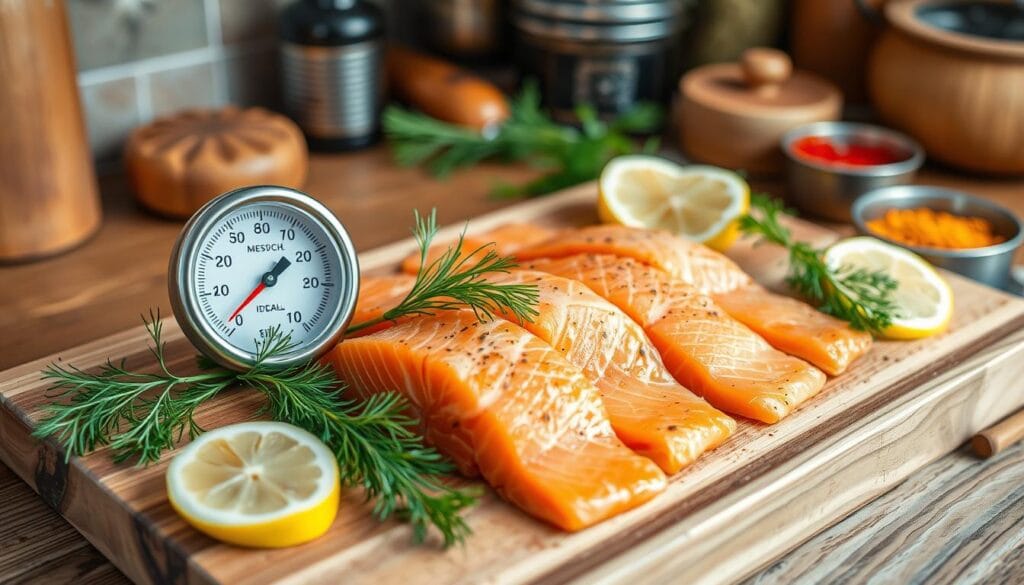
Proper storage keeps smoked salmon fresh. Cool it, then wrap in cling wrap and refrigerate for up to 5 days. Or, freeze it for up to three months in foil. This keeps it ready for your next meal.
Determining Doneness: Temperature Recommendations
To know when salmon is done, you need to check its internal temperature. Understanding the right temperatures ensures your salmon is both tender and flavorful. The USDA says to cook salmon to at least 145°F for it to be well-done. Here’s a guide on different levels of doneness.
Rare vs. Medium-Rare vs. Well Done
Here are the internal temperature ranges for different salmon doneness levels:
| Doneness Level | Temperature (°F) |
|---|---|
| Rare | 110°F |
| Medium Rare | 120-125°F |
| Medium | 130-135°F |
| Well Done | 140-145°F |
For medium and medium-rare, take the salmon off the heat at 125°F to 135°F. This allows it to cook a bit more without losing flavor. Cooking at lower temperatures can also prevent overcooking, which can make the fish look less appealing.
Factors Affecting Cook Time
Several things can change how long it takes to cook salmon:
- Thickness of the Fillet: Even thickness is key for even cooking. Uneven thickness can make it hard to tell when it’s done.
- Initial Salmon Temperature: Starting with room temperature can make cooking faster than with cold fillets.
- Cooking Method: Different ways to cook, like baking or grilling, affect the time. Baking takes about 15 minutes, while pan-searing is quicker, at just five minutes.
Using a food thermometer is the best way to check the salmon’s temperature. Look for flaky texture and a slightly pink color to confirm it’s done. With these tips, you’ll be able to make perfectly cooked smoked salmon fillets.
Tips for Avoiding Overcooked Salmon
To get a tender, flavorful salmon, it’s key to avoid overcooking. The right cooking methods can make a big difference. Here are some tips to help you keep your salmon moist and delicious.
Using a Digital Meat Thermometer
A digital meat thermometer is a reliable way to cook salmon perfectly. It lets you check the internal temperature without guessing. The USDA says to cook salmon to 145°F to kill harmful bacteria. But, many like it cooked to lower temperatures, like:
- Rare: 120°F
- Medium rare: 125°F
- Medium: 130°F
- Medium well: 135-140°F
- Well done: 140-145°F
A digital thermometer gives you accurate readings. This helps you avoid overcooking and ensures your salmon is safe to eat. Always check the thickest part for the best reading.
Low and Slow Cooking Approach
Cooking salmon low and slow is another great way to keep it moist. Lower temperatures help prevent overcooking. For example, baking at 350°F for 10-15 minutes cooks it evenly and keeps flavors intact. Here are some cooking times based on thickness:
| Thickness | Cooking Time |
|---|---|
| 1/2 inch | 5-8 minutes |
| 1 inch | 10-15 minutes |
After cooking, let your salmon rest for 3-5 minutes. This lets juices spread out, making it moist. Using these tips will help you cook salmon to perfection every time.
Dealing with Albumin in Smoked Salmon
Working with smoked salmon means understanding albumin in fish. Albumin is a protein that can form a white film on the salmon’s surface during cooking. This can make the dish look different, raising questions about its presence and how to manage it.
What is Albumin?
Albumin is a protein found in salmon, especially in the liver. It appears when fish is heated. When the internal temperature hits around 135°F, albumin starts to ooze out, making the salmon look overcooked. Though harmless, it can change the dish’s look, leading chefs to find ways to deal with it.
Strategies to Minimize Albumin Appearance
To make your smoked salmon look better, try these strategies:
- Wet Brining: Soak salmon in a saltwater solution, about a tablespoon of salt per cup of water. Even a 15-minute soak can help reduce albumin.
- Pellicle Development: Let the salmon air-dry before smoking. This creates a tacky layer that helps the smoke stick better, making albumin less visible.
- Cook at Lower Temperatures: Cooking the salmon at a lower temperature helps prevent albumin from forming. Aim for an internal temperature of 125°F to 135°F for the best texture.
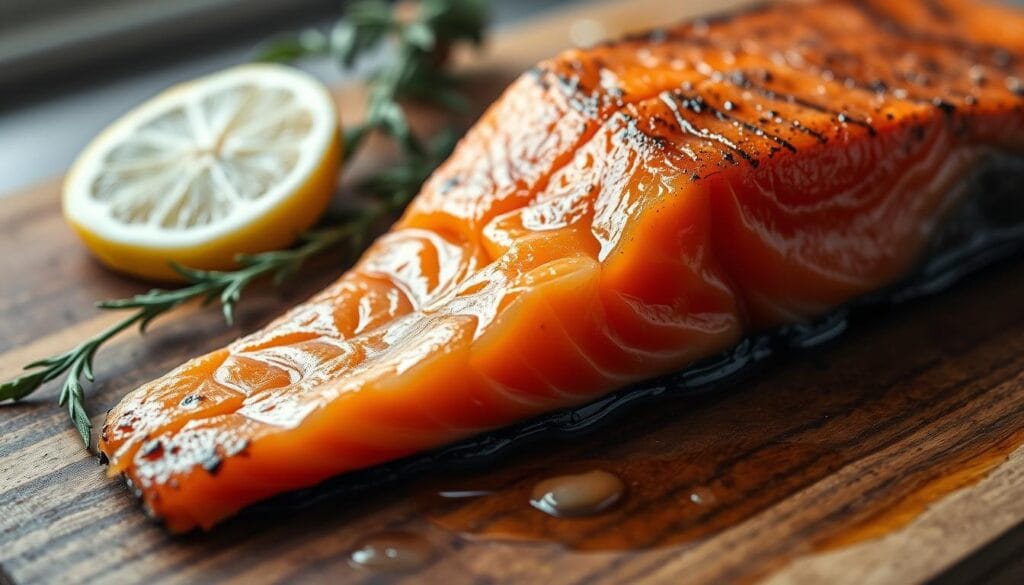
Partnering Flavors: Seasoning Your Smoked Salmon
Seasoning smoked salmon right can make it taste amazing. The right seasonings bring out the fish’s natural taste. Simple flavors like lemon pepper make smoked salmon a hit at any party.
Best Seasonings for Smoked Salmon
Here are some top seasonings for smoked salmon:
- Lemon Pepper – This classic mix adds zest and freshness.
- Brown Sugar and Paprika Rub – Sweet and savory, it boosts the smoky taste.
- Garlic Powder and Chili Powder – For a spicy twist, this blend is perfect.
- Herb Infusions – Dill, thyme, or rosemary add a fragrant touch.
Try a wet brine before smoking for moist, flavorful fish. Soak the salmon in seasoned saltwater for 20 minutes. This makes the fish tender and juicy.
Creating Delicious Party Food Ideas with Smoked Salmon
Smoked salmon can make your party special with tasty food ideas. Here are a few:
- Smoked Salmon Dip – Mix cream cheese, sour cream, and herbs with smoked salmon. It’s great with crackers.
- Smoked Salmon Tacos – Fill small corn tortillas with avocado, smoked salmon, and lime for a fresh take.
- Salmon Canapés – Top toast with smoked salmon, cream cheese, and capers for a fancy snack.
Adding these ideas to your menu will impress your guests. Smoked salmon dishes are not only delicious but also elegant.
Serving Suggestions for Smoked Salmon
Being creative and presenting smoked salmon well can make your meal better. It adds a unique taste and texture that people love. You can add it to many dishes, like salads and appetizers.
Incorporating Smoked Salmon into Dishes
Smoked salmon is great in many recipes. Here are some ideas:
- Pasta Salad: Mix smoked salmon with pasta, baby spinach, cherry tomatoes, and a light dressing for a healthy meal.
- Salads: Add smoked salmon to mixed greens, cucumbers, and fresh dill for a tasty salad.
- Toast Toppings: Spread cream cheese on toast, then add smoked salmon, capers, and cucumbers for a fancy appetizer.
- Canapés: Place smoked salmon on crackers or small blinis with sour cream and chives for easy appetizers.
Perfect Pairings: Side Dishes and Drinks
Choosing the right sides and drinks can make smoked salmon even better. Here are some good pairings:
| Type | Pairing Suggestions |
|---|---|
| Side Dishes | Roasted vegetables, dill potatoes, or a fresh green salad. |
| Drinks | Gewürztraminer, Riesling, or a chilled Moscato D’Asti to match the smoky taste. |
Storing smoked salmon right can keep it tasty longer. It stays good in the fridge for two to three weeks, or one week after opening. Freezing it also works, keeping it fresh for up to three months. Remember these tips for the best smoked salmon experience.
Conclusion
Getting the right smoked salmon temperature is key for great taste and safety. You want to aim for an internal temperature of 145-150°F. This ensures your salmon is perfectly smoked.
Trying out different smoking methods and seasonings makes cooking more fun. It’s all about enjoying the journey as you create your dishes.
Using various salmon types, like those from fishing tours with Phantom Tri-River Charters, can spark new ideas. Smoking not only keeps salmon fresh but also adds unique textures and tastes to your meals.
With the right focus on temperature and preparation, you can make delicious smoked salmon. This will make your kitchen adventures even more rewarding.

